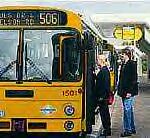
Light Rail Now/Light Rail Progress can be contacted at: Light Rail Now! |
NOTE: There's no question that "Bus Rapid Transit", or "BRT", can provide significantly better service, and attract significantly higher ridership, than "conventional" (i.e., local) bus service. "BRT" is commonly applied to virtually any bus service above this level, particularly express or limited-stop services operating on reserved, exclusive, or restricted-traffic alignments (such as HOV lanes). Busways, or "transitways", with online stations, undoubtedly represent the highest form of "BRT" operation, and this form figures prominently in the marketing efforts by the Federal Transit Administration and other agencies and organizations in the forefront of promoting "BRT". Unfortunately, this marketing activity typically contains, as its central thrust, the theme that "BRT" provides the same quality of service as light rail transit (LRT), "only cheaper". "Think rail, use buses" and "light rail on rubber tires" are common marketing slogans for the "BRT" concept. We believe these claims are refuted by the facts, and, therefore, this marketing campaign is inherently deceptive. This is underscored by the common "bait and switch" ploy of portraying a busway, but then "selling" BRT on the basis of costs and other features of considerably downscaled versions of the concept, such as the MetroRapid "BRT" service in Los Angeles (which operates in mixed traffic). The objective appears to be to cajole urban planners and decisionmakers to accept the proposition that LRT is a needless extravagance, and that buses alone can solve their public transport needs into the indefinite future. Responding to this contention is the primary focus of the following article, an editorial reprinted from Transit Australia (February 1999, page 36). While it dates from 1999, we believe that its basic information and arguments are still timely. Transitways: A triumph of marketing – A failure of rigorous analysis Bus-only roadways, being promoted under the sound good terms 'Busway' and 'Transitway', are being touted as a solution to the long term public transport needs of Brisbane and Sydney. The achievement of marketing this concept to Local and State Governments in Australia is undeniable. The failure of government agencies to properly evaluate the concept is disturbing and disappointing to those interested in the long term strategic development of realistic public transport infrastructure in Australia. A transitway is a bus-only roadway. The term was introduced by the Ottawa Regional Transport Authority (OC Transpo) in Canada to describe a bus-only roadway and associated infrastructure (stations and stops) built with the objective of avoiding the provision of rail-based public transport. There are no other transitways in Canada, indeed despite strenuous efforts by OC Transpo to convince other North American cities of the merits of the Transitway no other North American city has constructed a similar purpose built transitway. it goes without saying that European cities have shown little interest in the transitway concept.
A report commissioned by the Ottawa Regional Council has revealed that between 1984 and 1997 transit ridership dropped 18% from 86 million trips annually to 70 million trips. Over the same period, population increased by 24% resulting in an effective decrease of 32% in market share. Similar sized Canadian cities, such as Calgary and Edmonton, which opted for light rail systems achieved passenger growth over the same period. Despite the massive spending on the transitway OC Transpo's buses still run on-street through Ottawa's CBD and their on-time performance is extremely poor. OC Transpo's own figures show that in September 1997 approximately 40% of buses operating on weekdays did not meet the on-time performance standard. OC Transpo's 1987 forecast projection of 106 million passengers by 1996 was hopelessly optimistic with in reality only 71 million passengers being carried. All of the above information is available on the public record and yet a number of government agencies in Australia appear to be incapable of raising legitimate challenges to the transitway concept, the accuracy of the cost and time estimates being provided by its advocates and the ability of a system based solely on buses to provide acceptable public transport for the 21st century. How can these agencies justify their backing for such a transit option? There are two other bus-based transit systems which, at times, receive passing mention: the Adelaide O-Bahn and the Curitiba trunk system.
Effective transport planning demands the right mode for the specific task. in Europe, and in the more progressive North American cities, this is seen as ensuring the appropriate use of heavy rail, light rail and buses to provide quality public transport as a viable alternative to the private car. To concentrate solely on bus-based solutions to transit needs is to abrogate responsibility for balanced, practical, user-friendly and responsible solutions. it fails to address the environmental and social obligations placed on transport planners by today's society. To quote one of the largest public transport operators in the world, London Transport, "Today, in conurbations worldwide, buses are not perceived by passengers to be attractive, reliable and high quality means of travel, mainly because of delays caused by traffic congestion and the relatively poorer ride quality of buses against rail vehicles." London Transport goes on to state that modern tramway systems have become the most favoured systems for alternative ways of meeting the need for public transport systems which are more reliable than the bus but cheaper and quicker to build than underground railways." Updated 2003/04/07 |
|
|
|